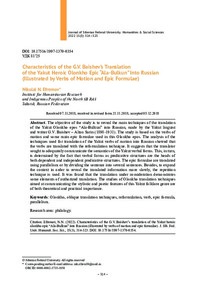Показать сокращенную информацию
Characteristics of the G.V. Baishev’s Translation of the Yakut Heroic Olonkho Epic “Ala-Bulkun” Into Russian (Illustrated by Verbs of Motion and Epic Formulae)
| Автор | Efremov, Nikolai N. | en |
| Автор | Ефремов, Н.Н. | ru_RU |
| Дата внесения | 2018-12-13T06:19:47Z | |
| Дата, когда ресурс стал доступен | 2018-12-13T06:19:47Z | |
| Дата публикации | 2018 | |
| URI (для ссылок/цитирований) | https://elib.sfu-kras.ru/handle/2311/109162 | |
| Аннотация | The objective of the study is to reveal the main techniques of the translation of the Yakut Olonkho epos “Ala-Bulkun” into Russian, made by the Yakut linguist and writer G.V. Baishev – Altan Sarin (1898-1931). The study is based on the verbs of motion and some main epic formulae used in this Olonkho epos. The analysis of the techniques used for translation of the Yakut verbs of motion into Russian showed that the verbs are translated with the reformulation technique. It suggests that the translator sought to adequately communicate the semantics of the Yakut verbal forms. This, in turn, is determined by the fact that verbal forms as predicative structures are the heads of both dependent and independent predicative structures. The epic formulae are translated using parallelism or by dividing the sentence into several sentences. Besides, to expand the context in order to reveal the translated information more slowly, the repetition technique is used. It was found that the translation under consideration demonstrates some elements of authorized translation. The studies of Olonkho translation techniques aimed at communicating the stylistic and poetic features of this Yakut folklore genre are of both theoretical and practical importance | en |
| Аннотация | Целью и задачами статьи является выявление основных способов перевода на русский текста якутского героического эпоса олонхо «Ала-Булкун», осуществленного якутским лингвистом и писателем Г.В. Баишевым-Алтан-Сарын (1898-1931). В качестве материала исследования были выбраны глаголы движения и некоторые основные эпические формулы, использованные в данном олонхо. Анализ способов перевода на русский язык якутских глаголов движения показывает, что эти глаголы переведены на русский язык способом замены. Подобный факт свидетельствует о том, что переводчик стремился точно передать семантику якутских глагольных форм на русский язык. Это, свою очередь, обусловлено тем, что глагольные формы как предикативные структуры являются вершинами тех или иных предикативных конструкций – зависимых или независимых. Эпические формулы переведены при помощи синтаксической замены – параллелизмами, а также расчленением предложения на несколько предложений. Кроме того, встречаются лексические и синтаксические повторы для расширения контекста с целью более медленного раскрытия передаваемой информации. Установлено, что в рассмотренном переводном тексте имеют место элементы авторизованного перевода. Изучение особенностей подобных переводов олонхо, ориентированных на воспроизведение стилистических и поэтических особенностей данного жанра якутского фольклора, имеет как практическое, так и теоретическое значение. | ru_RU |
| Язык | en | en |
| Издатель | Сибирский федеральный университет. Siberian Federal University | en |
| Тема | Olonkho | en |
| Тема | oblique translation techniques | en |
| Тема | reformulation | en |
| Тема | verb | en |
| Тема | epic formula | en |
| Тема | parallelism | en |
| Тема | олонхо | ru_RU |
| Тема | переводческие трансформации | ru_RU |
| Тема | замена, глагол | ru_RU |
| Тема | эпическая формула | ru_RU |
| Тема | параллелизм | ru_RU |
| Название | Characteristics of the G.V. Baishev’s Translation of the Yakut Heroic Olonkho Epic “Ala-Bulkun” Into Russian (Illustrated by Verbs of Motion and Epic Formulae) | en |
| Альтернативное название | Особенности перевода олонхо «Ала-Булкун» Г.В. Баишевым на русский язык (на примере глаголов движения и эпических формул) | ru_RU |
| Тип | Journal Article | en |
| Контакты автора | Efremov, Nikolai N.: Institute for Humanitarian Research and Indigenous Peoples of the North SB RAS 1 Petrovskogo Str., Yakutsk, Republic of Sakha (Yakutia), 677027, Russia; nik.efrem50@mail.ru | en |
| Контакты автора | Ефремов, Н.Н.: Институт гуманитарных исследований и проблем малочисленных народов Севера СО РАН Россия, 677027, Якутск, Республика Саха (Якутия), ул. Петровского, 1 | ru_RU |
| Страницы | 314–323 | |
| DOI | 10.17516/1997-1370-0354 | |
| Журнал | Журнал Сибирского федерального университета. Гуманитарные науки. Journal of Siberian Federal University. Humanities & Social Sciences; 2018 | en |

